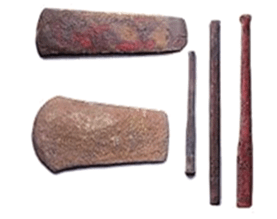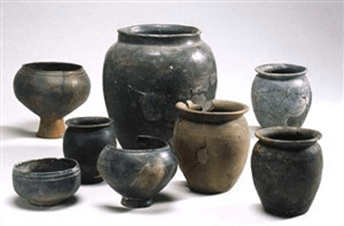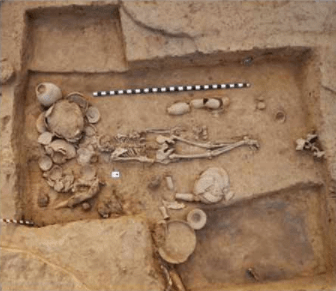UPSC Exam > UPSC Notes > Additional Study Material for UPSC > Causes for the Decline
Causes for the Decline | Additional Study Material for UPSC PDF Download
POST-URBAN PHASE OF IVC
- The Harappan culture seems to have flourished until 1900 B.C.
- Afterwards its urban phase marked by systematic town planning, extensive brickwork, art of script, standard weights and measures, distinction between the citadel and the lower town, use of bronze tools, and, red ware pottery painted with black designs practically disappeared.
- The post-urban phase of the Harappan culture is also known as the sub-Indus culture or the late Harappan culture.
- The late Harappan culture is primarily chalcolithic in which tools of stone and copper are used.

Chalcolithic tools of Post-Urban Phase of Harappan culture
- They do not show metal objects requiring complicated casting.
- The chalcolithic people in the late Harappan phase lived in villages subsisting on agriculture, stock raising, hunting and fishing.
- The post-urban Harappan settlements have been discovered in the Swat valley.
- Here the people practiced a developed agriculture and cattle breeding together with pastoralism.
- They used black-grey burnished ware produced on a slow wheel.
 Black-grey burnished ware
Black-grey burnished ware - The painted Harappan pottery found in the late Harappan phase lacked the intricate designs which were present in the Harappan phase.
- In the late Harappan phase no object for measuring the length is noticed.
- Also some places lacked the cubical stone weights which were present in the Harappan phase.
- Generally all late Harappan sites lack human figurines and characteristic painted designs.
- The post-urban phase of Harappa saw the end of the Indus trade with the West Asian centres.
- Lapis lazuli, chert, carnelian beads and copper and bronze vessels are either absent or scarce as trade items.
 Lapis lazuli and carnelian beads
Lapis lazuli and carnelian beads - All this was natural because most late Harappan sites excavated in Punjab, Haryana, Uttar Pradesh are mostly rural settlements.
- In the last phase of Harappan culture, few signs of insecurity and violence seem to have appeared.
- New types of axes, daggers, knives with midribs appear in the upper levels of Mohenja daro.
- Hoards of jewellery were buried at places and skulls were huddled together at one place.
- Some foreign intrusion and traces of new people seem to have happened in the late Harappan phase.
- At several places, Grey Ware (GW) & Painted Grey Ware (PGW), generally associated with the Vedic people, have been found in conjunction with some late Harappan pottery.
- All this can be attributed to the barbarian horse-riding people who may have come from Iran- THE ARYANS.
- But the Aryans did not come in such numbers as to completely overwhelm the Harappan cities.
- We do not have any archaeological evidence of any mass-scale confrontation between the mature Harappan and the Aryans.
 Possible route of Aryan invasion
Possible route of Aryan invasion
Causes for the Decline Aryan Invasion
There are many theories regarding decline of IVC. Some of them conflict and contradict each other!
- Change in the rainfall patterns: Around 2000 BC serious flooding in plains and cities
- Over utilisation of resources
- Ecological degradation: Decreasing fertility of the soil due to excessive exploitation
- Earthquakes and drying of rivers due to tectonic shifting
- Natural calamities like recurring floods
- Aryan Invasion as they had superior weapons as well as swift horses.
Controversy over Aryan invasion
- One of the discoveries (30 skeletons in the upper level of the site) made at Mohajo daro in the 1920s support the hypothesis that Aryan invaders destroyed the Harappa civilization. Dead bodies were found at Great bath which suggest that war had taken place between IVC and Aryans
 Burial and associated IVC grave goods
Burial and associated IVC grave goods - Reference to the destruction of forts by Aryans in the Rig Veda.
- Evidence of an alien culture immediately after it at some places such as Harappa and Chanhudaro.
- But this theory is negated as there is a gap of 250 years between decline of IVC and Aryan invasion and there are no evidences of weapon production and mass burials.
Controversy over Flood theory
- Recurring floods i.n., Mohenjodaro and Chanhu Daro, drying up of rivers e.g., Kalibangan and Banawali.
- Supporting evidence shows that Mohenjo-Daro and Chanhudaro got flooded 7 and 3 times respectively
But theory is not acceptable-
- Firstly, IVC people has knowledge of controlling floods as they had fortified and built walls in many places to keep floods away.
- Secondly, there is no chance of such great floods causing destruction to the whole civilization.
Theory of Ecological/Hydrological changes
- It is one of the most acceptable theory.
- It says that there was less rainfall from 1800 BC due to deforestation.
- Moreover River Saraswati has changed its course causing shortage of water.
- Further the Thar desert expanded, increasing the salinity of soil making the soil not suitable for cultivation.
Weaknesses of the Harappans
- Lack of plasticity of mind. The stagnation is shown by the unchanging style of building, art, utensils etc.
- There may have been social and moral degradation.
- There may have been difficulty in obtaining the equivalents of modern strategic raw materials, particularly copper and tin.
- Limited use of script as compared to the Sumerians.
- High degree of authoritarianism is also said to have been one of the weaknesses for the demise of civilizations.
Gradual Process of Decline
- At Mohenjo Daro, Jhukar, Chanhudaro, and Amri, there is evidence of a gradual deterioration in the last phases of Harappan occupation.
- The decline of trade, particularly oceanic trade with the Sumerians contribute to the gradual decline.
- The evidence points to a precarious economic situation as a significant reason for the downfall. The administration of the Harappan cities was also effective in handling the situation.
Survival & Continuity of IVC in the contemporary culture
Continuity in Religious Sphere
- An outstanding icon in Indian art appears in Harappan culture. It bears the first anthropomorphic representation of a deity in India, and that it shows the concept of Yoga to have been present in Harappan culture. It appears to delineate a prototype for the later Indian God Shiva.
- The seal show a central figure seated upon a low throne in yogic position. The arms, which are covered with bangles, are extended outward over the knees in a very reminiscent of the pose seen in later Chola bronzes of mediating Hindu gods.
- There are so many rituals items and cults of Harappan society such as the Mother Goddess, Lingas, Yonis, Swastikas which have become a part of later Hindus.
- The horned god, crowned by a large horned headdress, suggests the trident symbol of Shiva. He is surrounded by the four wild animals (elephant, tiger, rhino and buffalo) and beneath his stool are two deer just as in the representation of Buddha preaching his first sermon in deer park at Sarnath.
- Stone phallus, another symbol of Shiva, have also been discovered in the Indus valley ruins.
- Another interesting feature is the continuity of cattle worship and the way in which they are decorated till today. It is to be noted that the bull seals or cattle worship is resonated today in Nandi worship, another symbol associated with Lord Shiva.
- We find a more readily identifiable dancing figure in an incomplete male torso in grey stone from Harappa. The body is twisted into a pose which has invited comparisons with the great Chola icons of Shiva ie Nataraja.
- Worshipping trees, stones is still a continuing practice among the Hindu religion.
Continuity in Economic Sphere
- Discovery of standard weights and measures, some of which were continued to be used in India till recently.
- Basic unit of measurement became the basic unit of Indian rupee ie 16 Annas.
- The idea of standardization.
- Construction of an aritifical dock.
- The binary systems and other instruments of measurement and weights are still in practice.
- Potter’s wheel, carts and boats are still in use until today.
- During the past thirty years more than 350 Harappan sites have been discovered, out of which 200 sites are in Gujarat only.
- Pioneers in international trade.
- Practice of ship building still followed by fishing community
- Tradition of tilling the soil remains to be the same along with irrigation.
Continuity in Social Sphere
- Matriarchy is still present in some societies of Kerala and Meghalaya.
- Town planning is one of the unique aspects of IVC which we see in today’s municipal administration.
- Construction of houses with bricks and drainage system was borrowed from IVC.
- IVC house construction has become basis for Vastu-shastra.
- Hobbies like dancing, boating, racing are still pursued by people.
- Pioneers in the cultivation of cotton. Cotton was first used by the Harappans.
- Use of wheat as the staple diet in North India.
- Consumption of food products, both veg and non-veg as practiced by Harappans, is followed even today.
- The Indus valley people used ornaments. Even today women wore enormous number of bangles.
- They used ivory comb and mirror which are exactly the same as those that are used today.
- Children of the period played with terracotta toys. The same sort of toys are being used by the children of today in rural India.
- The veneration of animal and domestication of fowl still continued in modern times.
The document Causes for the Decline | Additional Study Material for UPSC is a part of the UPSC Course Additional Study Material for UPSC.
All you need of UPSC at this link: UPSC
|
20 videos|561 docs|160 tests
|
FAQs on Causes for the Decline - Additional Study Material for UPSC
| 1. What are the main causes for the decline in the UPSC exam success rate? |  |
| 2. How does the increasing competition impact the success rate of the UPSC exam? |  |
Ans. The increasing competition in the UPSC exam has a direct impact on the success rate. With a higher number of applicants, the competition becomes intense, making it more challenging for candidates to secure a position. The increased competition means that candidates need to score higher marks and perform exceptionally well in all stages of the exam to stand out from the rest. This elevated level of competition has contributed to a decline in the success rate as only a limited number of candidates can make it through the rigorous selection process.
| 3. Why does inadequate preparation affect the success rate of the UPSC exam? |  |
Ans. Inadequate preparation significantly affects the success rate of the UPSC exam. The exam syllabus is vast and covers various subjects, requiring candidates to have a thorough understanding of each topic. Insufficient preparation leads to a lack of knowledge and understanding, resulting in poor performance in the exam. Without proper preparation, candidates may struggle to answer questions accurately or effectively manage their time during the exam. As a result, their chances of clearing the exam and achieving a high rank decrease.
| 4. How does the difficulty level of the UPSC exam impact the success rate? |  |
Ans. The difficulty level of the UPSC exam plays a crucial role in determining the success rate. Over the years, the exam has become increasingly challenging, testing candidates' knowledge, analytical skills, and decision-making abilities. The higher difficulty level poses a greater challenge for candidates, making it harder to score well and secure a position. The tough nature of the exam also increases the chances of making errors or struggling with time management. Consequently, the difficulty level contributes to a decline in the success rate.
| 5. What role does the limited number of vacancies in government services play in the decline of the UPSC exam success rate? |  |
Ans. The limited number of vacancies in government services has a significant impact on the success rate of the UPSC exam. With a limited number of available positions, only a small fraction of candidates can secure a job. This creates intense competition among applicants and increases the difficulty of clearing the exam. The limited vacancies also mean that even candidates who perform well may not be able to secure a position due to the high competition. Consequently, the limited number of vacancies contributes to a decline in the success rate of the UPSC exam.
Related Searches


















